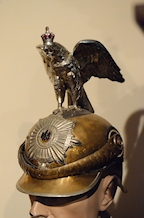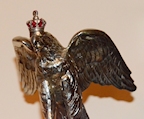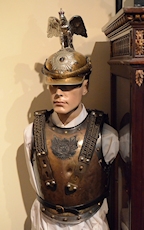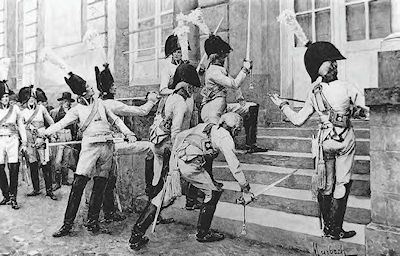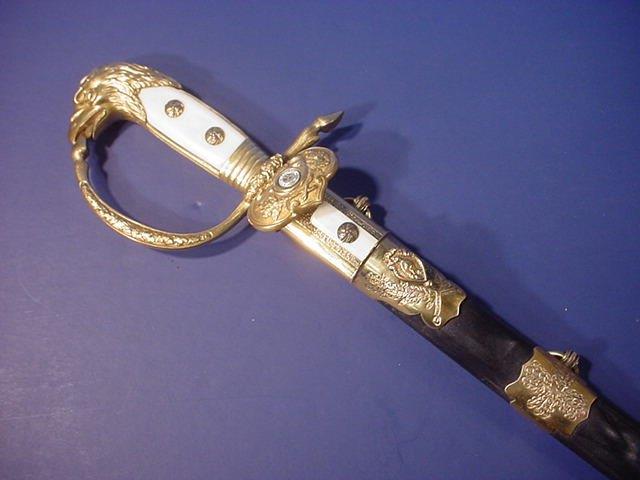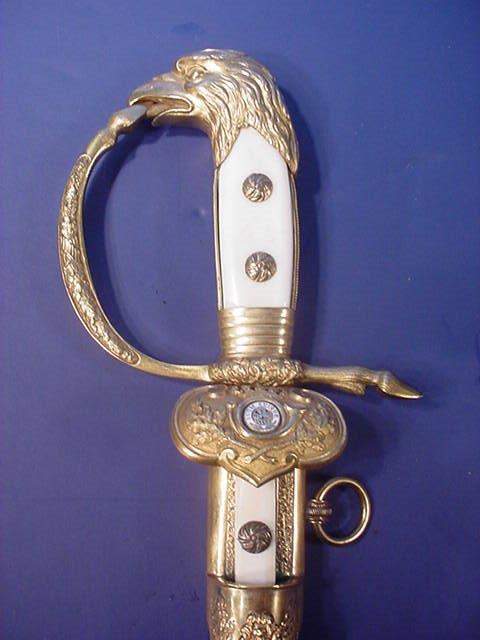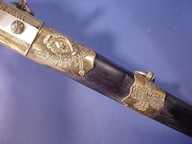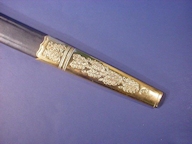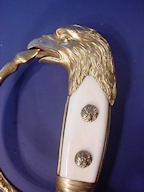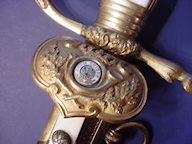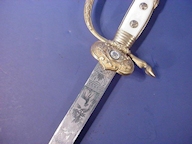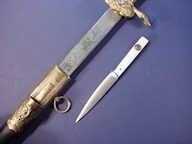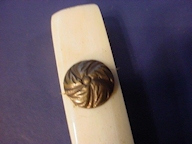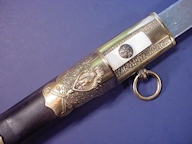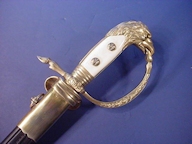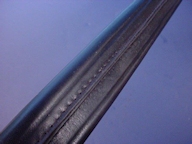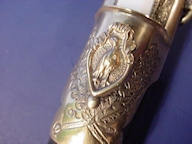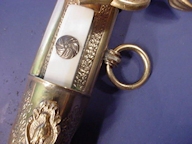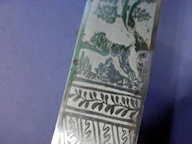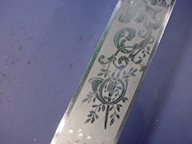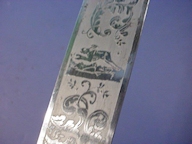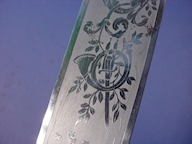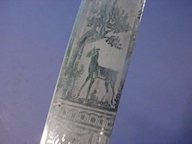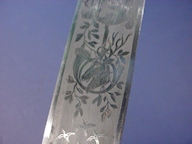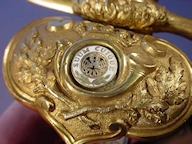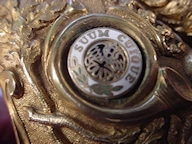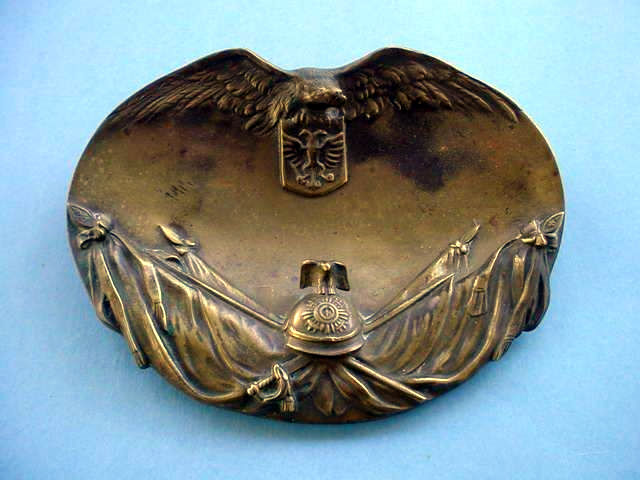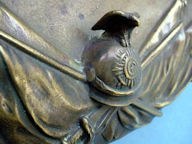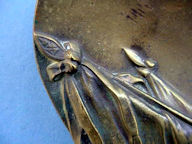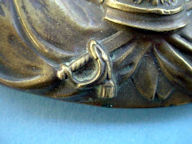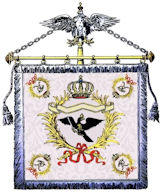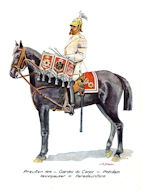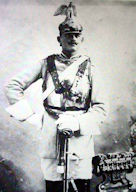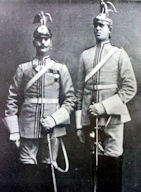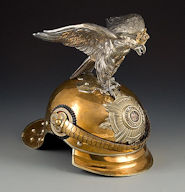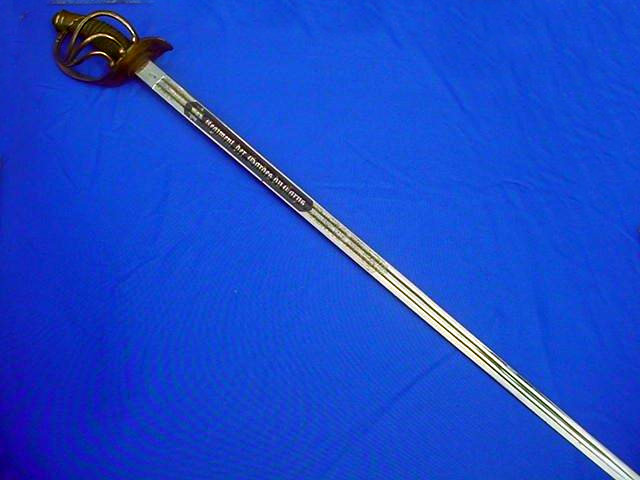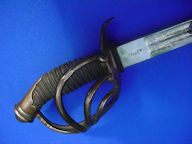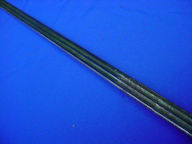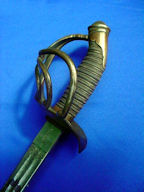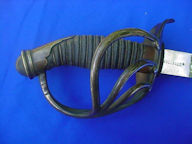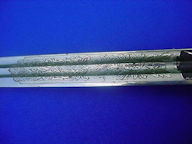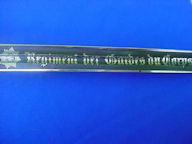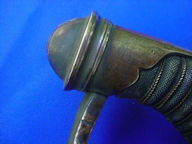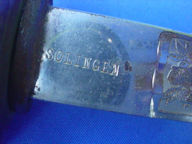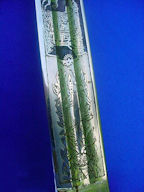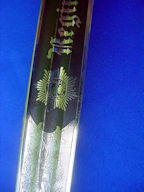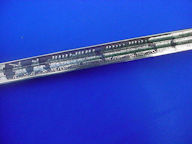|
|
|
|
Gardes du Corps
Page 1
|
|
Presentation Gardes du Corps Sword (Very Special!) (Item GDUCORP 1-A; ANTWEP 4-25) |
|
DESCRIPTION: This is one of the greatest presentation swords of the German Imperial period that we have ever encountered. It is a model 1889 degen. You can view this very sword on page 199 of Thomas Wittmann’s book Collecting the Edged Weapons of Imperial Germany, Volume I. To quote Tom, this is a sensational lion-head sword presented to a retiring officer from the Kameraden in the Gardes du Corps (the Kaiser’s personal bodyguard regiment). The obverse blade is beautifully gold inlaid over the blue background panels. The blade ricasso features a mounted Gardes du Corps officer with drawn sword and eagle-top helmet. The inscription on the obverse blade translates to: “Major von Gersdorff from his comrades in memory of service in the regiment Gardes du Corps.” The reverse blade features the names of the presenters; almost without exception all are of Imperial royal lineage. Mr. Wittmann certainly makes no exaggeration in saying this: “One can run their finger softly down the blade and realize that this is a work of particular excellence far beyond the norm in German swords.” On the obverse of the blade are images of the eagle-top dress parade helmet and a potpourri of assorted weapons and the Imperial standard of the corps. The maker’s name as seen in two places is Ewald Cleff in Solingen. The grip is tightly wrapped in sharkskin and the lion’s head bears two rubylike eyes. Almost every hair on this old monarch’s head is separately distinguishable. It should be noted that one of the personages presenting the sword is Heinrich, Prince of Prussia (brother of Kaiser Wilhelm II). Almost every family name is preceded by the word “von.” Also, plainly seen, is Friedrich Leopold, Prince of Prussia, and other princes. There are at least 32 names that include Prussian counts, princes, and other very important nobility. The sword, including the grip, measures slightly over 40 inches long. Members of the “Gardes” were always quite tall. The image featured in a plaque known as the langet is a Roman Centurion. This is appropriate as these early warriors made up the bodyguard regiment to the Caesars. When the sword rests in its scabbard, it measures about 42 inches from the boot to the top of the lion’s head. The scabbard is of tombac material with brass carrying rings and bands. The sword is in excellent-plus condition, but the scabbard is a bit grainy from years of wear and then storage. Without a single doubt this is one of the most exciting finds in the collecting of Imperial weaponry.
Price = PRICELESS, but priced at $14,500.00 |
|
|||||||||
Framed Picture of the Gardes du Corps Potsdam (Item GDUCORPS 1-1) |
|||||||||
| DESCRIPTION:This is a group picture of the officers of the Regiment of the Second Squadron of the Garde du Corps stationed at the Prussian city of Potsdam. This is a reprint of one of the Erinnerunglsbilder, or souvenir picture. This would be the item that would be bought or issued to the retiring or mustering-out soldier for a memory of his service time in this elite guard unit. Various ranks with a different uniform and headgear are shown to include the famous Garde du Corps eagle atop the high-dress helmet that is seen on several of the guardsmen, regimental pipes, regimental beer steins, cuirassier swords, musical instruments permeate the scene and, of course, the requisite mug of beer is held possessively in the hands of most of the participants in “photo day.” There are also shields bearing legends concerning the corps of royal guards. The GDC was the personal guard regiment to the German Kaisers and the royal palace. This is a large print measuring 22 ½ x 27 inches. It is newly framed and matted with the correct German colors: black, white, red. This would be a great centerpiece for any good German Imperial helmet collection.
PRICE: $195.00; the framing cost $95.00 alone; print is rare |
Prussian Gardes du Corps Helmet in Mint Condition (Item GDUCORPS 1-3; KHELMET 2-11) |
|||||||||||||||||||||
| DESCRIPTION: Here is an astoundingly beautiful helmet of a Garde du Corps officer in immaculate condition throughout. Never that we know of has such a beautiful example been offered on the worldwide web. The Garde du Corps was the personal bodyguard of the king of Prussia and after 1871, the German emperor (in “German” Kaiser). It was founded in 1740 by Frederick the Great with Friedrich von Blumenthal as its first commander. He died suddenly in 1745, but his brother Hans von Blumenthal, who, with the other officers of the regiment had won the Pour le Merite at its first action at Hohenfriedberg, assumed command in 1747. Hans von Blumenthal was wounded leading the regiment in a successful cavalry charge at Lobositz and had to retire from the army. Initially the regiment was used partly as a training ground for officers as part of a programme of expansion of the cavalry. Early officers included the rake and memoirist Friedrich von der Trenck, who describes the arduous life of sleep deprivation and physical stress endured by officers, as well as the huge cost of belonging. The Cuirasses, for example, were silver-plated. Unlike the rest of the Imperial German Army, the Garde du Corps was recruited nationally and eventually reached a full crops strength. The Regiment wore a white cuirassier uniform with certain special distinctions in full dress. These included a red tunic for officers in court dress and a white metal eagle posed as if to fly on the bronze helmet. Other unique features of the regiment’s full dress as worn until 1914, included a sleeveless supraweste with the star of the Order of the Black Eagle on front and back and the retention of black iron cuirasses edged with red, presented by the Russian Tsar in 1814. These replaced the normal white metal breastplates on certain special occasions. This helmet has the Tombak metallic body with large convex style gilt chin-scales secured to clover leaf rosettes; one with the colors of the German nation and the other the black and white Prussian colors. The parade eagle stands upon a silvered clover- leaf base the body of the eagle is silvered metal, the crown is in gilt for officer’s. The guard star frontplate is on silvered metal with an enameled black eagle order ensign in the center. The liner is intact made of a silk type but rugged material. The sweat band is perfect in soft leather. There are 4 extra holes for attachment of the spike for normal every day usage. Inside the helmet is the washer with turn screw and bolt and under this is the makers mark that is J. Wagner and 1916 (date or mod.No?) This is the ‘finest’ and is worth repeating. You will never, never, find a better one. This is truly the epitome of an excellent Imperial relic. PRICE: Sold at auction. |
Gardes du Corps Beer Stein (Item GDUCORP 1-4; KSTEIN 2-4; MRBSTEIN 1-16) |
|||||||||||||||||
| DESCRIPTION: This is official Stein of the elite corps of the Kaisers personal bodyguard Regiment in Berlin and Potsdam. Formed in 1871 they wore resplendent uniforms with white with gold trim, a beautiful breastplate armor cuirasse with the Prussian guard star, and a resplendent helmet in brass and on its top sits the Prussian Imperial eagle in full dimension as he prepares to” wing It” to the sky this Eagle is unique to the GDC. You can see more about this if you go to K. helmet 2-6 in our Kaiser Reich section. The Stein is in the pottery style and is about a foot tall from the bottom to the top of the pewter guardsmen top. It has going around it various printed and spirited sayings. The Illusion of bravado and “Korpgeist”is prevalent; it is in perfect shape and is considered the best example the military Stein collectors can ever find. It is colorful indeed as expected from such an elite unit such as this one. It was from the property of a recruit in the fourth Regiment of the Garde Du-Corps stationed at Potsdam. The name shown is Paul Arnds. His name can be found on the two sides at the top of the central design. This design includes the Prussian crown, various regimental standards helmet, bayonet back pack and a white GDC., shoulder board. Under this is an image of a GDC horseman riding with his lance at the forefront. At the Top there is a statement about his love for his Regiment. Down the sides of this Stein are the names of his comrades of the Regimental. Comrades who served with him from 1905-1908 (about 35 names) and his own are listed. On the back panels are two scenes beautifully presented. One shows a GDC rider with horse and a pretty Fraulein who says “the horse belongs to Das Konigs, - - - Der Reiter 1st mein!” (This steed is the Kings, the rider is mine!) On the other side there is a depiction of the whole troop on the attack, and it says “Unser Garde Du Corps Atakerein muss der Starkste Feind verlieren” (when the Garde Du corp attacks even the powerful enemy will fall - -or lose!). The pewter top has an effigy of a GDC rider and a jumping horse, and the usual patriotic motifs are here as well. It also has black, white, and red color ribbons with oak leaves and acorns. All throughout the base are German national colors. It is marked German patent protected on its bottom, this item is handsome, rare and the historical importance is evident with this magnificent Stein. (See also the beautiful Garde du Corps officer's helmet at Khelmets 2-11).
SOLD This was a very special Garde stein. If you have one exactly like this we will be interested in buying it. |
 |
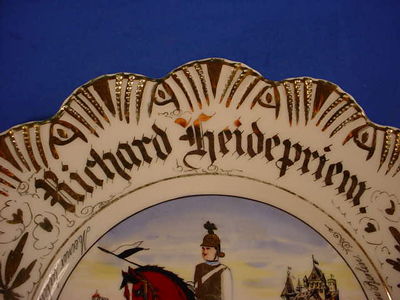 |
Gardes du Corps Commerative Plate From 1909 Berlin (Item GDUCORP 1-5) |
|||
| DESCRIPTION: Here is a beautiful plate purchased in 1909 by a Garde du Corpsman. The piece is, in my mind, so very precious that I practically hand carried it on the plane trip home from my last trip to Germany. To observe its many beautiful features and decorations, see our attached pictures and you can see some of the story and description of this elite regiment of Imperial Guards written in the articles elsewhere on this page and around the picture of the mounted guardsman. It has a legend that translated says “My beloved sister Marie at the Easter Celebration in 1909. From your loving brother Richard at the 1st Battalion of the Garde Kurass. Reg. in Berlin.
At the bottom of the plate are the words “Friede, Freude, Gluck, und Segen Sei Auf Allen Deinen Wegen" which translated means Freedom, Joy, Luck and Blessings are due to you. The plate measures 11 inches in diameter and is in unchipped, perfect condition with minute wear to the letters at the bottom, but since it is 100 years old I guess you can excuse that (I do!).
It is unmarked as to the maker but at that period of time this is not at all unusual.
A great G.D.C. item of beauty and historical importance. PRICE: SOLD |
|||
|
Silver Stickpin from the Gardes du Corps (Item PINS 8-15 & GDUCORP 1-6 & KJEWELRY 2-18) |
| DESCRIPTION: This was the Royal Bodyguard Regiment of the Imperial German Army that guarded the person of three Kaisers: Wilhelm I; Frederick, his son; and Wilhelm II, his grandson. The stickpin would be worn by members of this elite corps. The eagle-topped helmet is the symbol of the Garde du Corps. The pin is in pure ‘935’ silver and on some of them the gold or gilded crown is still evident; however, the information has come to us that these pins were not restricted to veterans of the corps, but could be purchased by admirers, who wanted to show their admiration of this grand unit.
PRICE: $225.00 |
|
||||||||||||||||||||||||||||||||||||||||||||
|
Guestbook of a Regiment of the Gardes du Corps at Potsdam: January 1904 to August 1921 (Item GDUCORP 1-7; KHISTORY 1-15) |
||||||||||||||||||||||||||||||||||||||||||||
| DESCRIPTION: It can truly be said that Germania International has over the years turned up and offered the greatest and most historically important Germanic articles than any other site in the cyber world. Now, we have outdone ourselves with the greatest find ever! So important that almost anything offered on other sites rather pales in significance. Bragging? Well, YES, we are bragging for, other than the Kaiser Reich throne that we feature, this has to be the Crème de la Crème! If the German government had its pride back this would be one of the most highly sought-after relics of the grand age of the Kaisers ever discovered—it would be featured in a secure, illuminated glass showcase—in a secure Chamber of the Deutsches Historisches Museum on the Unter den Linden and proudly displayed where German people could view it and reflect on the days of grandeur and refinement; the age of Imperial Majesty. This is the guest book of the Gardes de Corps with signatures all the way from 1904 to 1921. The Gardes du Corps was first established in 1740 by Emperor Frederick II (The Great) as a personal bodyguard to the King of Prussia. They were always considered (The elite of the elite!) Frederick Blumenthal was the first commander. The guest book contains almost 1,000 signatures and was signed by persons who either visited the Potsdam Garrison of the G.D.C. or by persons seeking an audience with Kaiser Wilhelm II, or the empress. Practically every single name in the book has some sort of history that would be in the annals of the German nation’s glorious history of distinguished guests. Am I revealing my identification as an incurable romantic and consummate Germanophile? Notable dignitaries that are found on the many pages are for instance, ambassadors, consuls, generals, professors, and officers of various regiments. Some of the names seen were well-known illuminaries in WW II; for instance, Adolf von Beckendorf, Hasso von Manteuffel, von Reppard, von Hohenau, von Prittwize, Hermann Kiefier, Lettow Vorbeck, Chanceller von bullow, von Papen, von Felgenhauer Kleemann, just to name a few. Also, most WW I zeppelin commanders, division commanders, and other well-known personages from political circles and aristocratic nobility are included. In addition, many countesses and Freifrauen visited the Gardes du Corps; chief surgeons, and Reich music directors, professors in high academic standing, and state ministers are amongst the guest list. It would take numerous months for a genealogist or academically trained professional historian to investigate each and every person who signed this fantastic book. It reads like the ultimate who’s who of German greats. Herr Wilhelm Reinhard Gehlen, our translator, and historical advisor and a very astute researcher studied this spectacular book for several months and did a superlative job of researching the various signatures. He put together over 100 typed pages that identify many of the signatures. When one actually takes the time to absorb what is seen in the two three-ring binders that he produced you can only be swept off your feet when the importance of this collection sinks in. We cannot find the words to fully describe just how prodigiously pertinent this is to Germany’s history. That this volume manifests and brings forth the importance is obvious and the sheer beauty of the book and its case is abundantly compelling. The cassette that encases the precious book measures 12 x 17 inches and is about 1 ½ inches thick. The case is covered in rich, deep maroon velvet fabric and its corners have beautiful brass supports in rich 1880’s design motif. In the center is an actual Prussian Gardes du Corp officer’s helmet plate with the gorgeous black Prussian eagle in enamel that is plated over a white enameled circular background that has the motto ‘Suum Cuique’ (To each his own). This helmet plate represented the star of the Prussian Black Eagle Order and in its arms you see the statement “Mit Gott für König und Vaterland 1866.” When the brass catch is opened and the cover lifted there inside a fitted indentation you can see the cover of the simple leather-covered guestbook with the words embossed in gold “ Gästebuch Regiment der Gardes du Corps.” At the underside of the velvet case are four small brass squares and these are the feet that support the precious book as it would lie on the table in the entrance to the G.D.C. area that one would enter before actually being escorted to the great hall of guards or the passageway to the Hohenzollern Palace. But no matter how important the person might be, they must have passed through the Gardes du Corps security station and signed the guestbook. Besides all the famous German luminaries that signed the book there are many foreign dignitaries as well; many Russians, Swedes, French, and Danish ambassadors as well as English and Japanese VIP’s and more. I could go on all day about the beauty and great importance of this wondrous item, but this certainly will more than thrill the imagination of those of my readers who are the “Kulturtragers” among us. It is certainly not for those considered who unfortunately are termed Belanglose! What really could compare? An entire book could be written that contains and explains only part of the importance of the various signatures seen here. We offer this spectacular item at a price that seems almost ludicrously reasonable in the hopes that it will eventually find its way to a German official state archive or a museum collection. Germania offers it with the wish that it returns to the Vaterland in dignity and to be cherished in the manner it obviously deserves as a national treasure of the Reich. PRICE: SOLD |
|
||||||||
|
Spectacular Helmet and Cuirass of the 2nd Garde Regt. of the Gardes du Corps (Item GDUCORP 1-8; KHELMET 2-16) |
||||||||
| DESCRIPTION: Here, in all its glory, is an eagle-top parade helmet and cuirass of the elite Gardes du Corps of the royal bodyguard regiment of the Kaiser’s guard formations
This is the regalia of the enlisted personnel of this elite formation. For more information about this illustrious military unit of Prussia read the other descriptions that accompany other such offerings, above. Like the Allgemeine-SS Leibstandarte-AH that developed later as the epitome of elite soldiers of the state security forces, the Gardes du Corps also marched to the cheers and ovations of the people who thronged the streets for the dress parades through Berlin. The membership to this corps was usually reserved for the sons of nobility and was limited to a small, but specially selected, recruitment of aristocratic candidates. They were basically a cavalry regiment, which actually fought bravely in the campaign of 1866 against Austria. They covered themselves with the laurels of victory and glory at the battles of Skalitz, Schweinschädel, and Königgrätz. The music composed that went by the name of ”Militärmarsch Preußens Gloria” (“Prussia’s Glory”) was written in honor of this regiment. They made an imposing sight as seen about the Hohenzollern Palaces with their white uniforms, white horses, and eagle-topped helmets. The officers wore the same uniform basically as the enlisted personal except for a few exceptions; they wore silver regimental cyphers on their ammo pouches, their cuirass had a silver-enameled Prussian crest instead of the one made of zinc as seen on the enlisted ranks, they wore a holster cover with the Gardes star backed with enamel, and the star on the helmet was enameled and much more pronounced and of jeweler-made quality. See the officer’s helmet at GDUCORP 1-3 in the articles above; also see the guestbook just above for an excellent image of the officer’s helmet plate; the enlisted plate is in two-piece construction the small eagle in the center being a separate attachment. The enlisted-man’s style also has a football-shaped base under the eagle’s feet while the officer’s has a cloverleaf design. There is a single dent in the cuirass that looks like a musket ball hit, but I doubt that. More likely it is from a fall from a horse during the constant everyday practice at horsemanship experienced by these horse troopers when not on parade. Prussia, one of the horse-loving countries, possessed horses in plenty and of course furnished men for the cavalry who from their childhood were at home in the saddle. As cavalrymen all of the various rider regiments enjoyed great reputations in Europe and especially the Gardes du Corps. Since the time of the great Frederick II Prussian cavalry had a reputation that struck awe. Under such leaders as the renowned Friedrich von Seydlitz the Prussian cavalry achieved the great state of perfection. So great was its reputation in the Seven Years’ War that Napoleon—remembering that—made a special point of warning his officers and men in 1806 to beware of the Prussian cavalry!
We offer this outfit helmet and cuirass to museums or a dedicated collector in the hopes that it will find a good home. It is a very exciting and historically important find and extremely rare. A helmet similar to this was in Cowan’s Auctions in April and brought $3,450, but unlike the one we offer, it was severely damaged and repaired in several places. The cockade was a plastic replacement and the scale buckle was missing. The liner was missing and the visor’s interior had been repainted.
I would call the condition 65 percent, while ours is 98 percent. The cuirass is always much more rare than the helmet and it is also in top condition with the hinged back and chest straps with chain upon leather. (Usually missing on examples found.)
So, if we want to talk extreme rarity and desirability beyond collector comprehension, here it is. Nothing could garner more attention in your collection than this ensemble. The crème de la crème!. If you would like to hear the beautiful and martially stirring music of "Prussia’s Glory" click here. PRICE: SOLD |
|
||||||||||||||||||||||||||
|
Deluxe Hunting Cutlass Attributed to the Kaiser’s Guard Regiment—Das Regiment der Gardes du Corps (Item GDUCORP 1-9; HUNT 8-9; ANTWEP 2-29) |
||||||||||||||||||||||||||
| DESCRIPTION: Here is a breathtaking example of a royal hunting weapon of the Prussian nobility. Unlike the much smaller examples that have a dog or a boar motif pommel, this one features a bold and handsome Prussian eagle as its crowning feature. All the metal parts of this piece are heavily gold plated. The grip of the weapon is crafted in white bone, as is the grip of the skinning knife. The eagle head looks a lot like the eagle motif on a Gardes du Corps helmet and we feel we can ascribe this wonderful weapon to that regiment. This, of course, was the famed regiment whose function was to be the personal guard to the German Kaisers of the Prussian Hohenzollern dynasty. Further evidence of this can be seen on the clamshell guard where you can see an enameled plate with the symbol of the Gardes du Corps on it surrounded by a hunting horn, oak leaves, and acorns, and this is surmounted with the Prussian crown of the empire.
The crown at this time—mid 1700s to the late 1800s—was only seen on royal articles: such things were closely regulated. This is no peasant piece. It is 100-percent either royal or at least owned by the officers of the elite GDC. The bone grip of the main cutlass and on the skinning knife are decorative roundels that are described as Sonnenrad (sun wheels). This was known to be another symbol of the various guard regiments. This weapon measures 29 inches in its scabbard with a blade measuring 21 inches long. The blade is quite beautiful employing various etched hunting scenes with stags, boars, game birds, rabbit, wolf, hunting horn, and many wonderful floral designs. On the backside of the blade (about 8 inches of it) are in much-used shape as these Hirschfänger were not only beauty contest participants, but were actually used on the royal hunting sport. That usage does not merge into but a tiny bit of the floral etching. All in all, the entire piece, except for this blade usage that really does not at all detract from it, is in practically mint condition and is nothing short of prodigiously spectacular!
PRICE: SOLD Germania International will not ship any item that contains any animal parts to any country where such items are prohibited! |
|
||||||||||||
|
Business Card Plate from the Gardes du Corps Command Office (Item GDUCORP 1-10) |
||||||||||||
| DESCRIPTION: Here is what I would have to say is a real rarity in Imperial relics. The Gardes du Corps (Regiment der Gardes du Corps) was, of course, the elite of the German military forces. It had early won the honored position of being the guard detachment that protected the Hohenzollern monarchs Wilhelm I, Frederick II, and Kaiser Wilhelm II. The headquarters of the unit was at the Berlin Hohenzollern Palace at Potsdam. I believe this bronze tray was no doubt in the desk of the command duty officer in each location. Probably only two were in existence and we could say it is therefore extremely rare! It depicts in its artistic presentation the distinctive Gardes du Corps helmet with eagle top resting upon four imperial regimental banners. At the crest of the tray you can see the German eagle with its wings spread for flight while in his claws is a shield that bears the familiar eagle as used in the Hohenzollern crest. This plate is in solid bronze and the helmet’s eagle is designed in such a way to grip the commander’s personal cards. The piece measures 7½ x 5½ inches and was beautifully cast in heavy bronze. This is a truly gorgeous relic of a finer and better time.
PRICE: $450.00 |
|
||||||||||||||||||
|
Fantastic Sword of the Elite Prussian Gardes du Corps (Item GDUCORP 1-11; ANTWEP 4-24; Special Items) |
||||||||||||||||||
| DESCRIPTION: The Gardes du Corps (Regiment der Gardes du Corps) was the personal bodyguard contingent of the King of Prussia and, after 1871, of the German emperor (in German, the Kaiser). The unit was founded in 1740 by Frederick the Great. Its first commander was Friedrich von Blumenthal, who died unexpectedly in 1745; his brother Hans von Blumenthal, who, with the other officers of the regiment had won the Pour le Mérite in its first action at the battle of Hohenfriedberg, assumed command in 1747. Hans von Blumenthal was badly wounded leading the regiment in a successful cavalry charge in the battle of Lobositz and had to retire from the military. Initially, the regiment was used in part as a training unit for officers as part of a program of expansion of the cavalry. Early officers included the rake and memoirist Friedrich von der Trenck, who described the arduous life of sleep deprivation and physical stress endured by officers, as well as the huge cost of belonging to the unit (the cuirasses, for example, were silver plated at a time when the precious metal was exceptionally expensive). Unlike the rest of the Imperial German Army after German unification in 1871, the Gardes du Corps was recruited nationally and was part of the 1st Guards Cavalry Division. The regiment wore a white cuirassier uniform with certain special distinctions in full dress. These included a red tunic for officers in court dress and a white metal eagle poised as if about to rise from the bronze helmet on which it sat. Other unique features of the regiment's full dress worn until 1914 included a red sleeveless Supraweste (survest) with the star of the Order of the Black Eagle on front and back and the retention of black iron cuirasses edged with red which had been presented by the Russian Tsar in 1814. These last replaced the normal white metal breastplates on certain special occasions and of course the most important piece of equipment of the elite guardsman and his most treasured passion was his SWORD. For the most part, this was a heavy cuirassier-style sword like the one Tom Wittmann shows in his book Collecting the Edged Weapons of Imperial Germany. On page 165, then on pages 166 and 167, he shows illustrations of cuirassiers wearing the degen or pallasch. He describes it as one of the most sought-after degens by collectors and the one pictured is in Tom’s personal collection. It is a great sword indeed, but not Gardes du Corps!!! Our sword, however, sadly is lacking a scabbard. Who knows what mystery attends this fact. Unfortunately, the wonderful weapon cannot talk. If it could it would surely weave the saga of battles glorious and deeds victorious! The sword sans scabbard still remains an absolute treasure in the museum and collectors’ world. The piece is quite large measuring 42 inches long from the pommel to the tip of the blade (a massive sword for a very big man). These Gardes du Corp officers were selected for many reasons but size certainly mattered! Most of them were at least six feet tall and looked seven feet tall when wearing the eagle-top helmet. This sword was constructed in such a way as to be effective as a weapon in combat; however, since this was the Kaiser’s elite guard it had to be special in every way. The blade is highly engraved with the name of the regiment in Germanic script. Just before the regimental name you can see the Gardes du Corps motto centered in a star. This reads “Suum Cuique” translated “To Each His Own.”). Following this regimental design the blade has the words “Regiment der Gardes du Corps.” At each end of the legend are deeply engraved floral patterns. On the reverse side is a beautiful depiction of royal guardsmen in a charge with the commanding officer in front with a bugler behind him and a whole regimental following all wearing the eagle helmet. The blade is made in the combat style with triple blood grooves. Even the top edge of the blade as it flows to the end of the engraving is decorated with oak leaves. The maker’s mark is for Clemen and Jung and their logo is on the reverse section of the blade nearest the guard. The grip is covered in ray skin with brass wire running down and wrapped along the length. The obverse side is stamped “Solingen.” The sword’s blade is in excellent-to-mint condition and has the most beautiful unsharpened finishes that we have ever seen on a Solingen blade.
PRICE: SOLD |
Page One |
Please refer to item designator in parentheses in all correspondence.
Please E-mail for any additional information you may need.If you prefer, contact 'Germania' at PO Box 68, Lakemont, GA 30552
or call at 706.782.1668.
Please! do not call during the wee hours of the morning. The best time for calling us is between 9 and 11 am and between 9 and 11 pm eastern time.


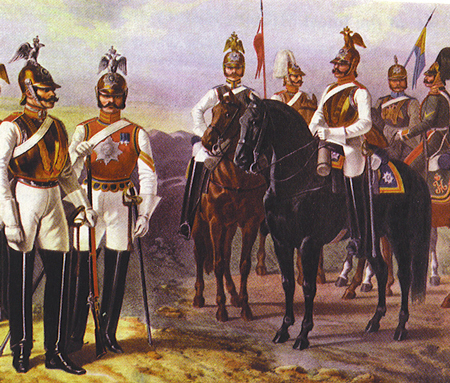
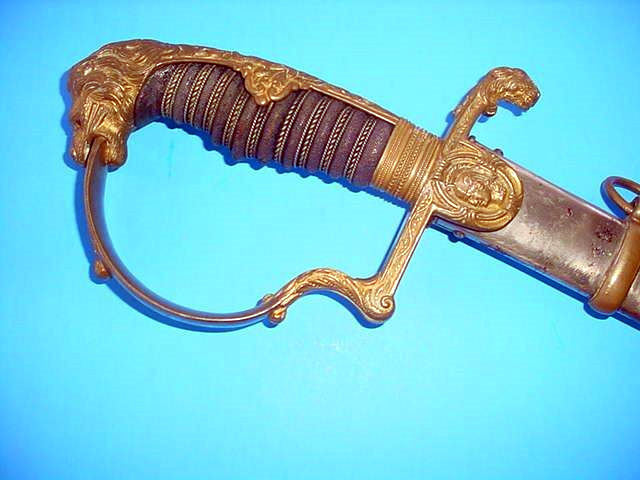
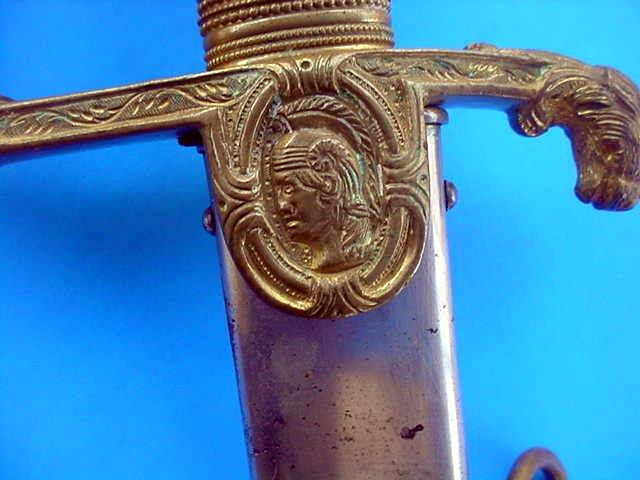
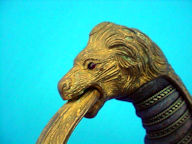

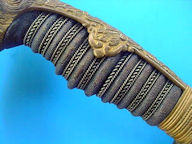
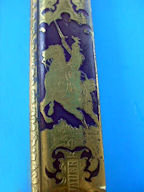
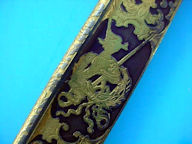
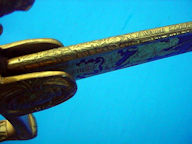
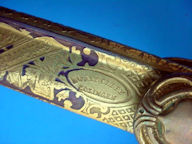
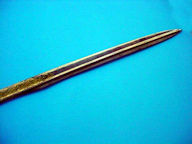
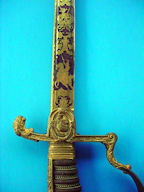
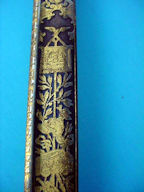

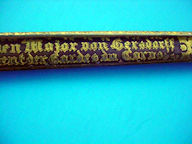

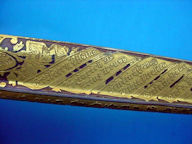
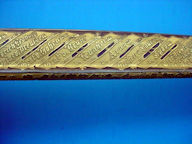
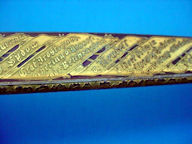

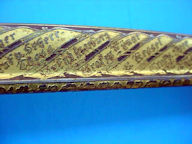
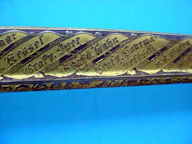
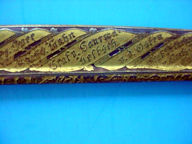
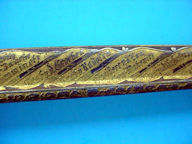
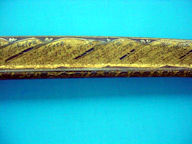
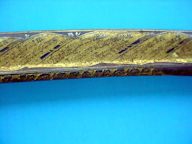
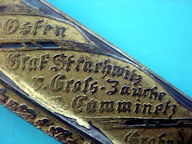
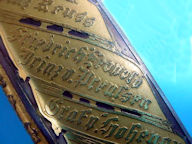
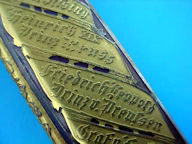
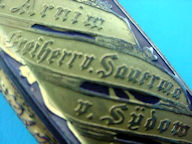
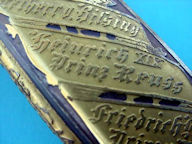










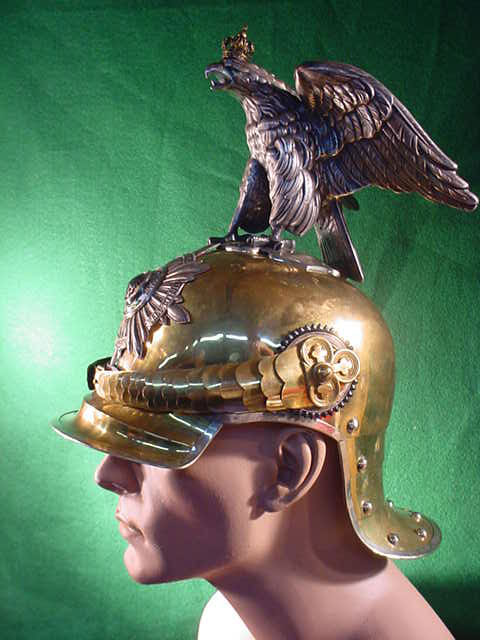
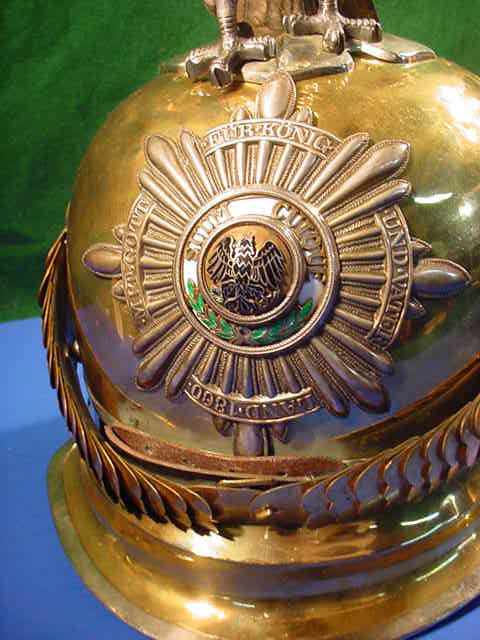
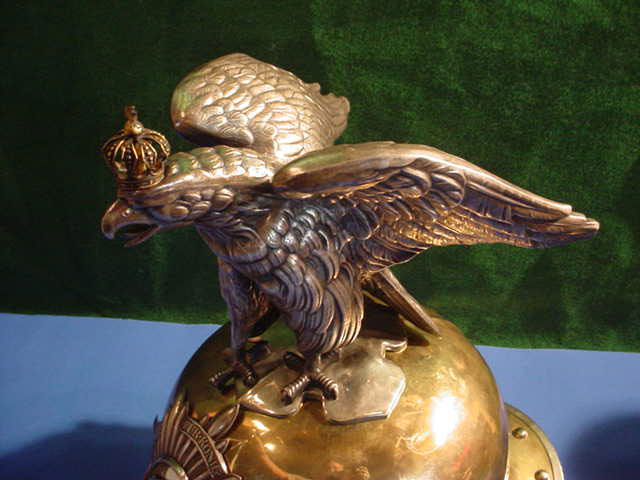
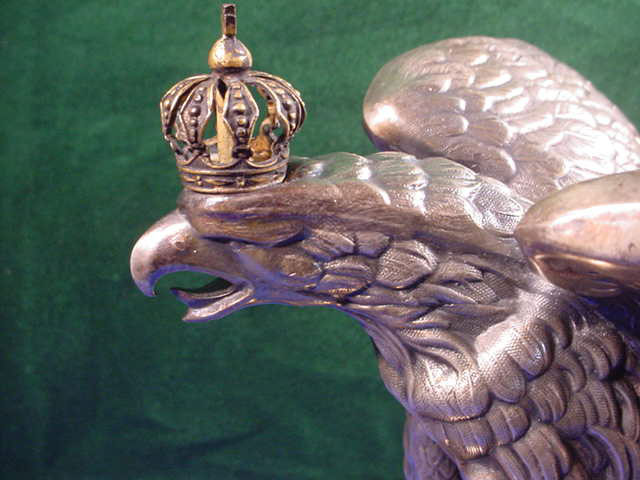
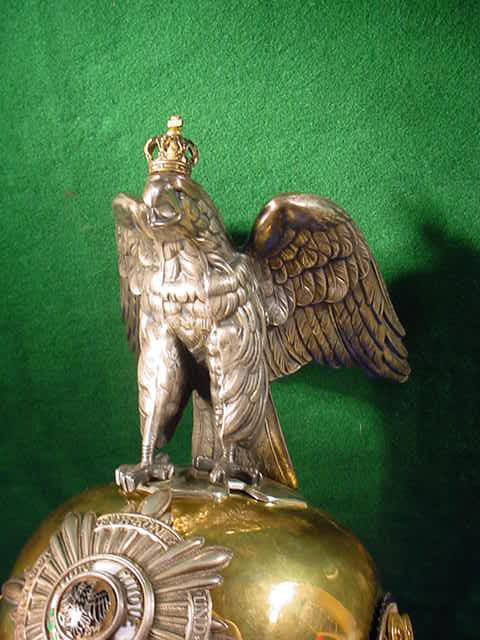
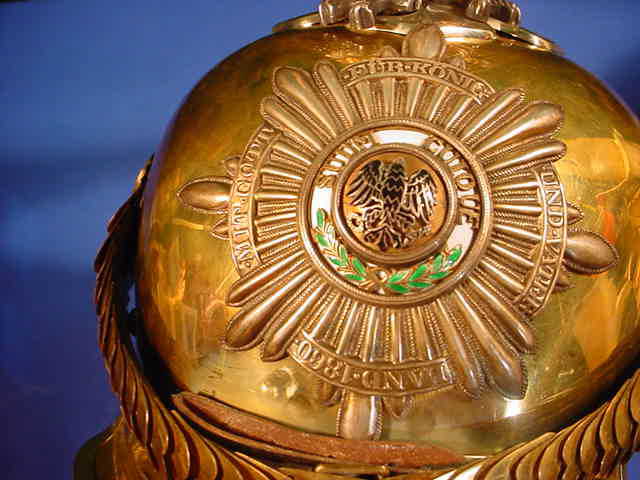
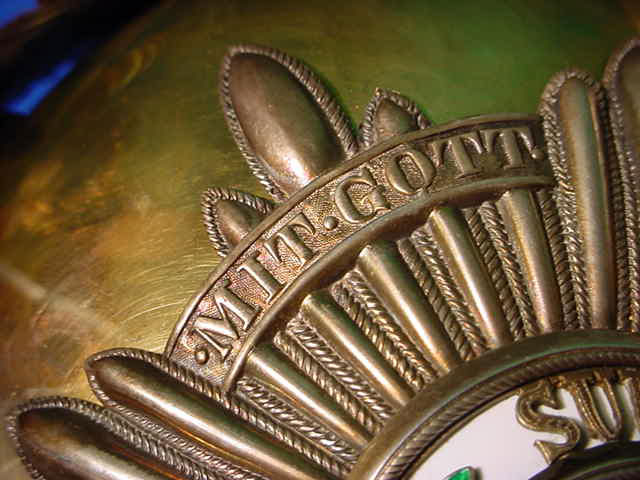

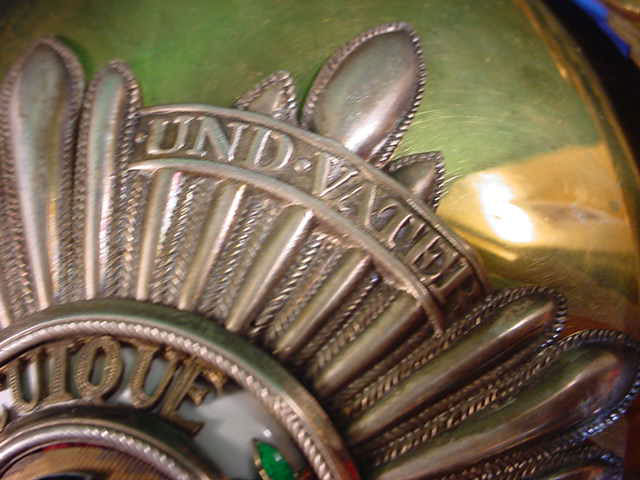
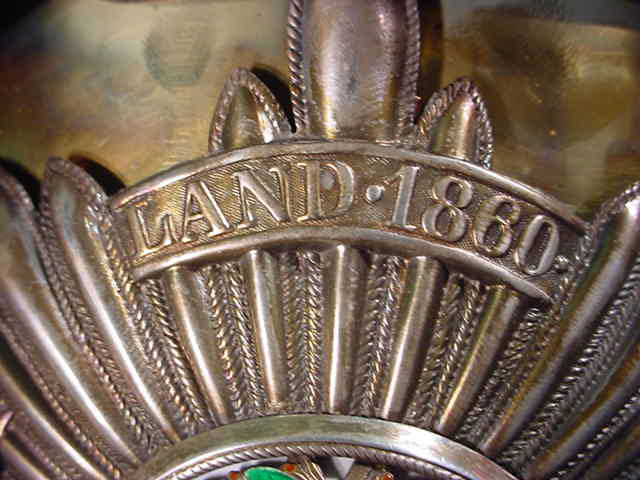
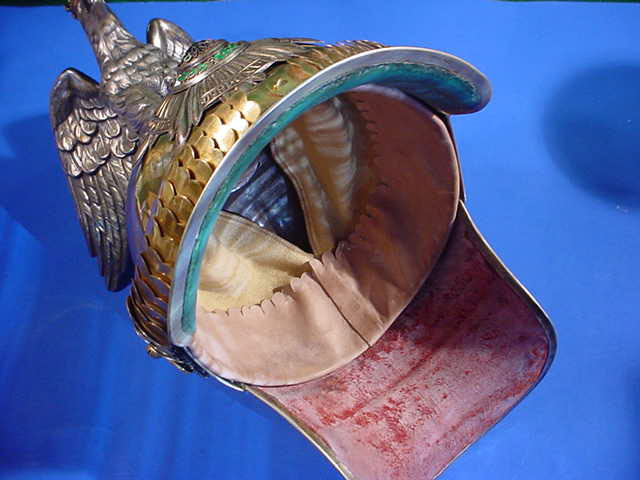

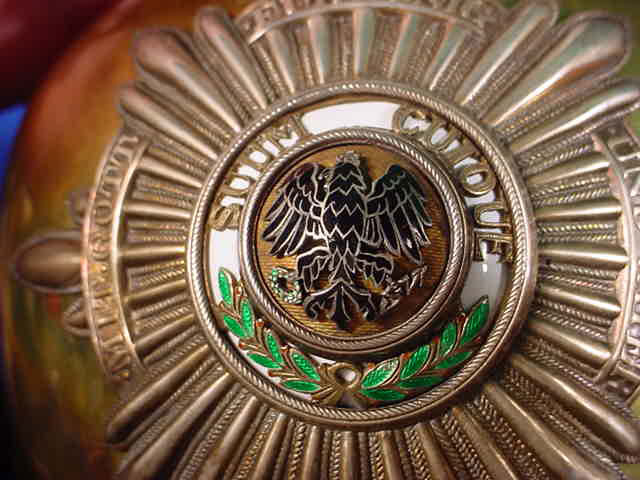
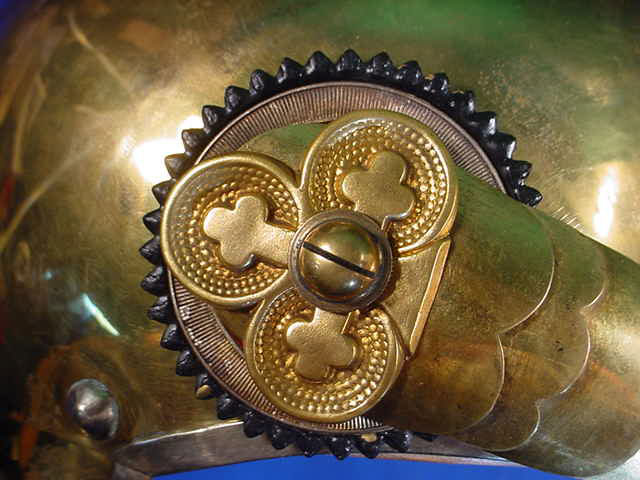

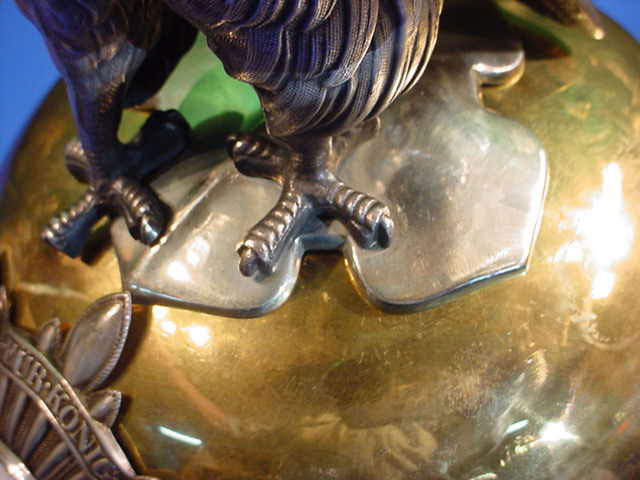

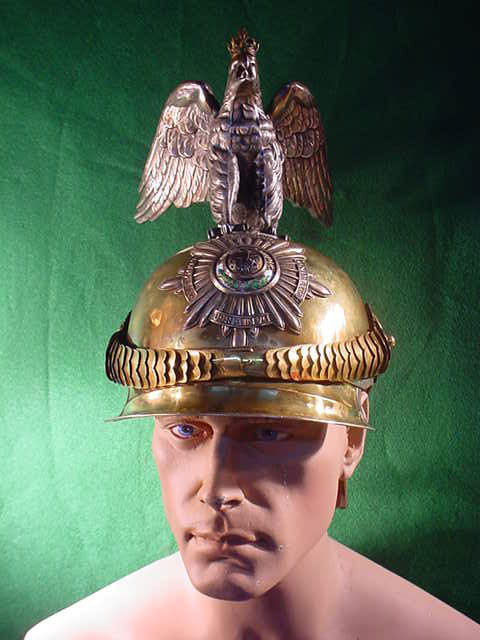



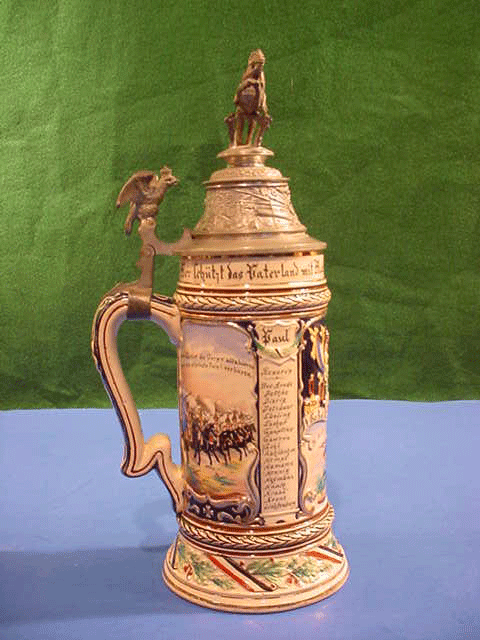
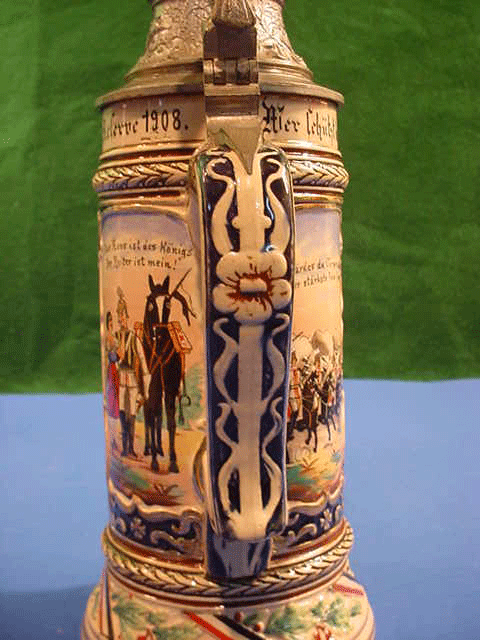
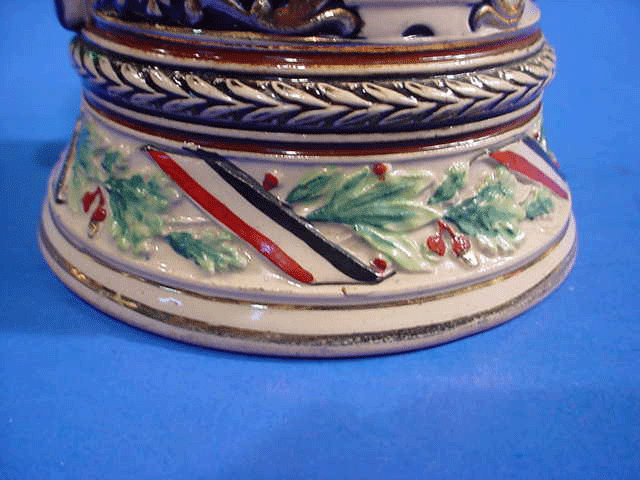


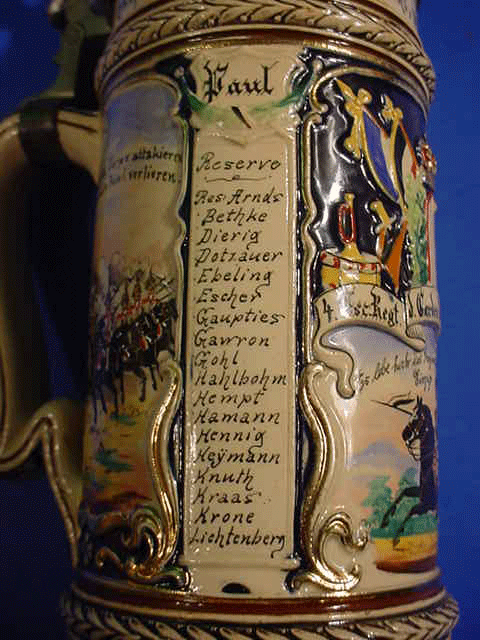
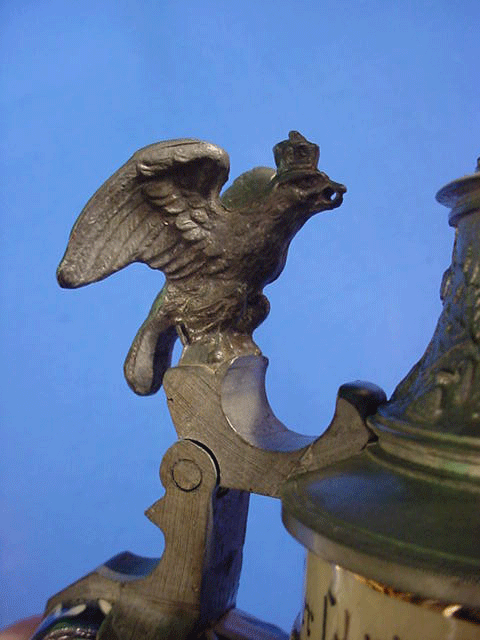
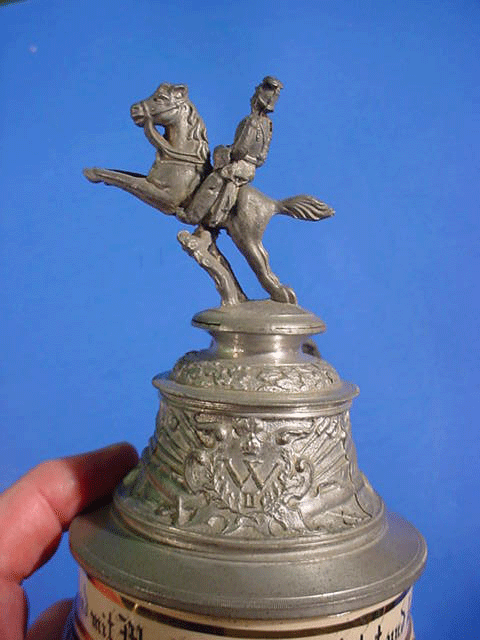
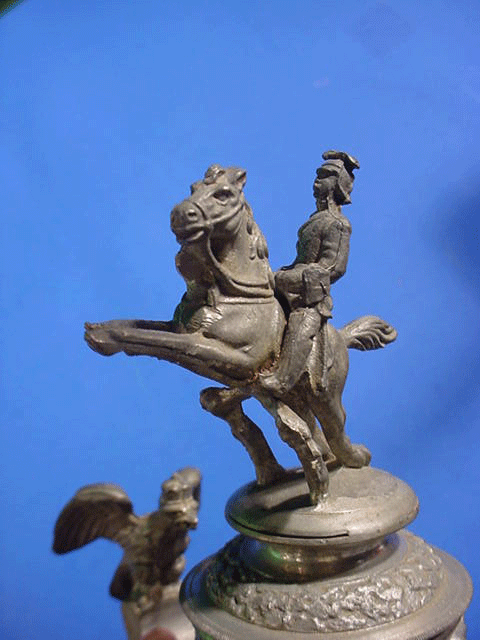
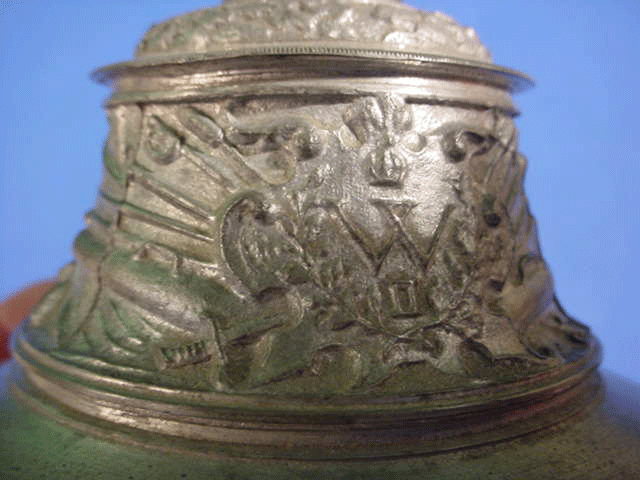
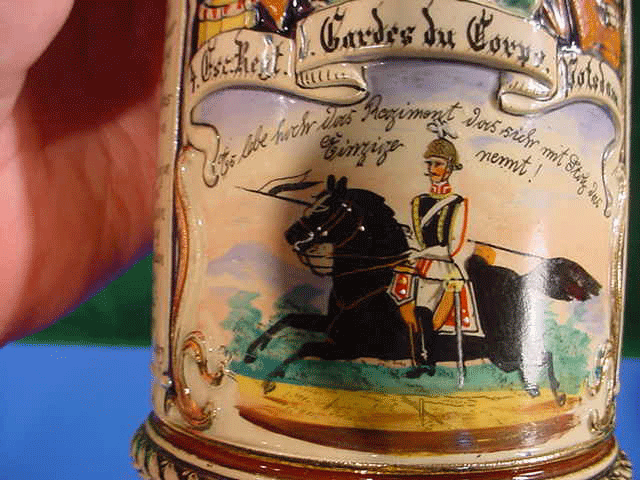
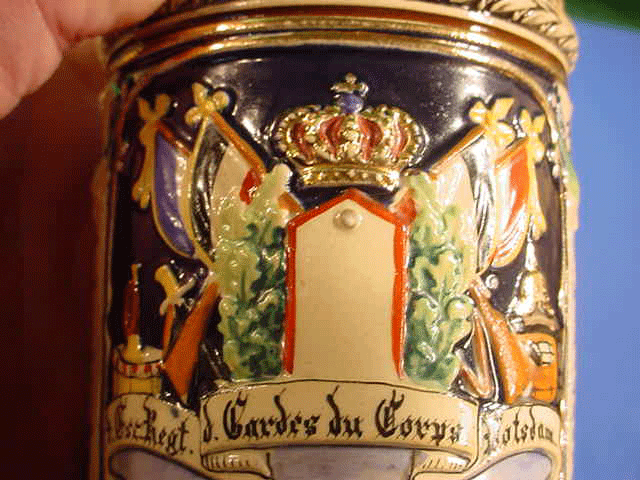
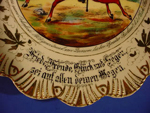
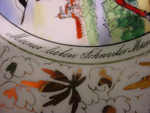

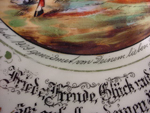
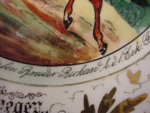
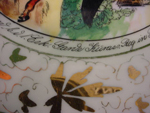
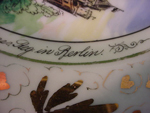
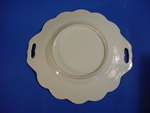
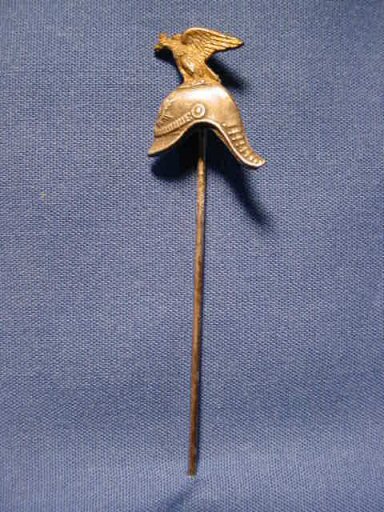



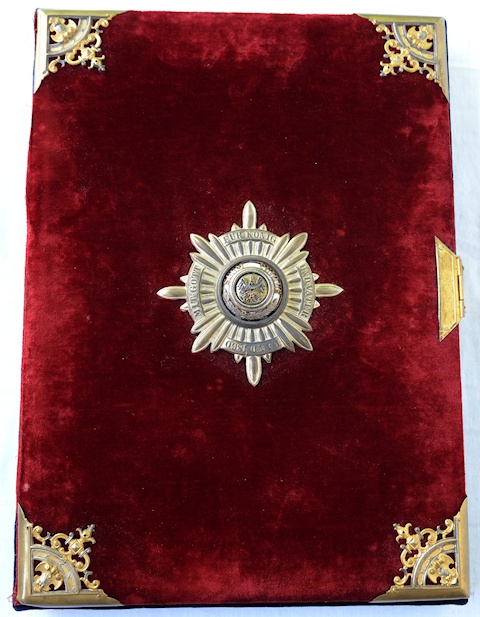
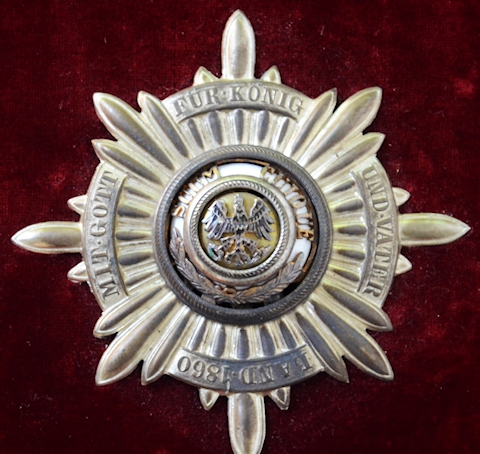
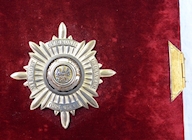

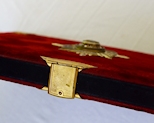
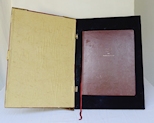
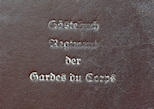
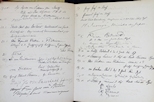
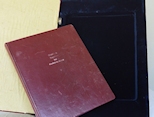
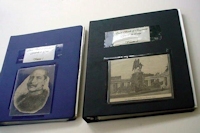
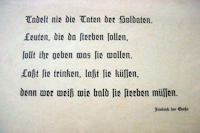
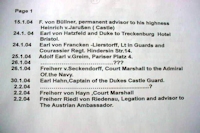
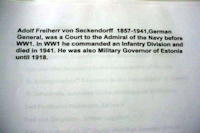

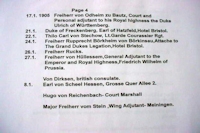


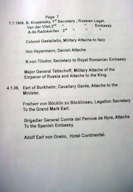
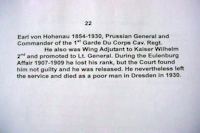
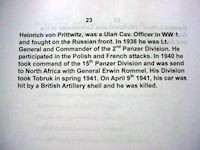
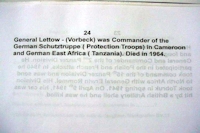

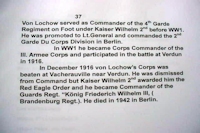
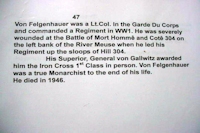
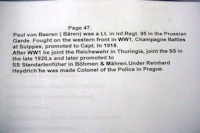
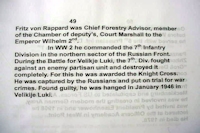
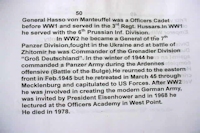
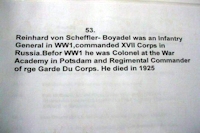
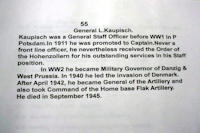
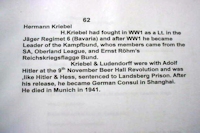
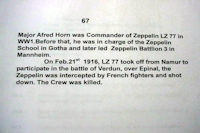
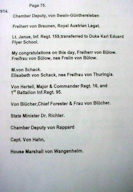
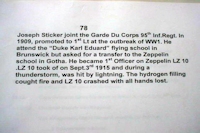
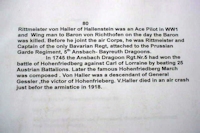
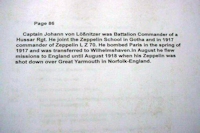
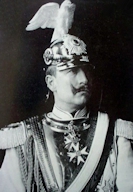

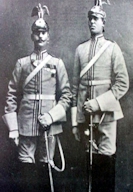
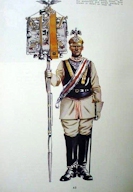
.jpg)
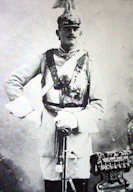
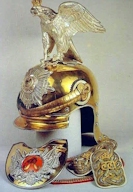
.jpg)



